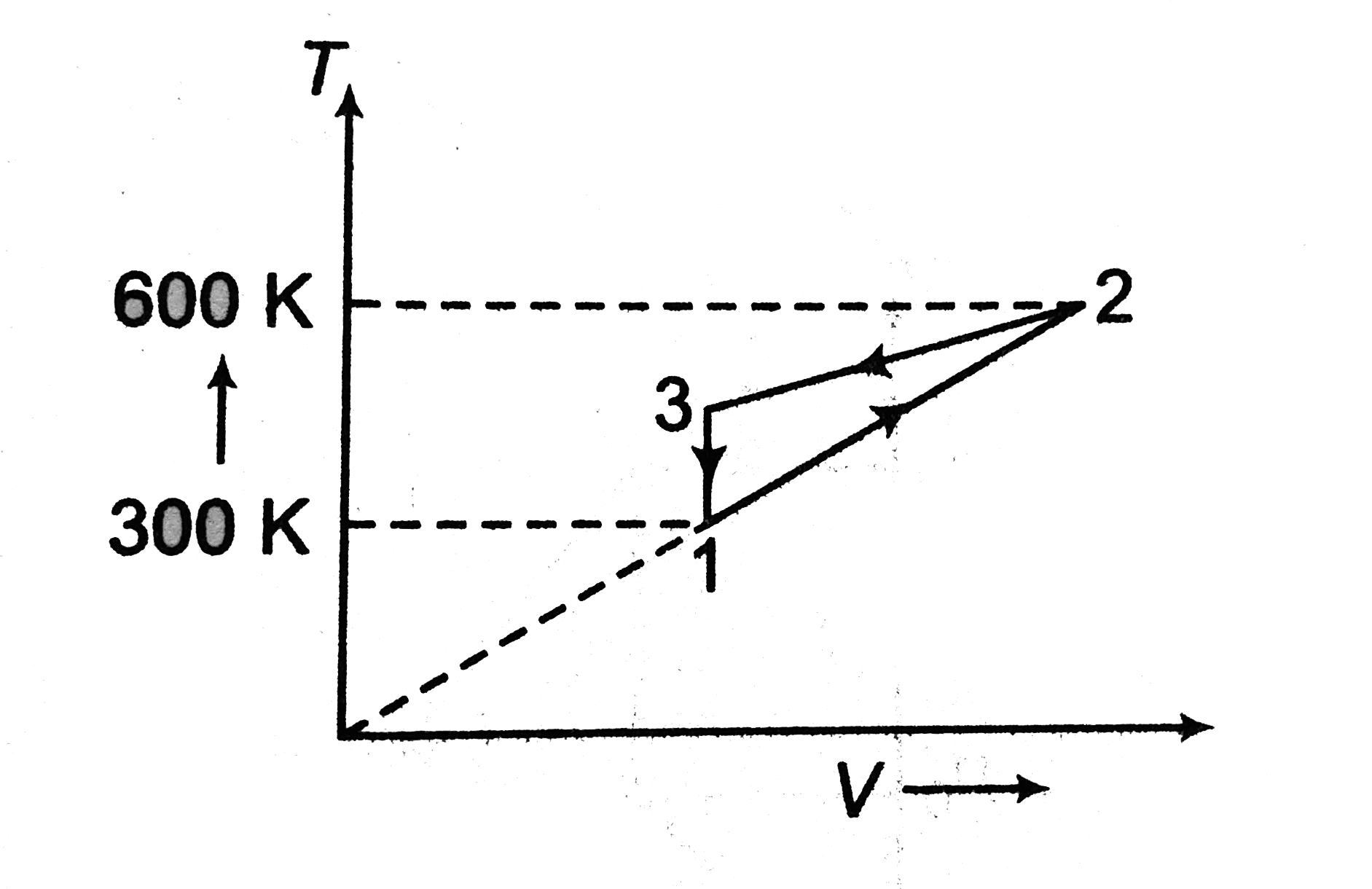Two moles of an ideal gas was heated isobarically so that its temperature was raised by 100 K. The heat absorbed during the process was 4000 J. Calculate (i) the work done by the gas, (ii) the increase in internal energy and (ii) the value of y for the gas [R=8.31Jmol−1K−1].
To solve the problem step by step, we will calculate the work done by the gas, the increase in internal energy, and the value of γ (gamma) for the gas.
Given Data:
- Number of moles, n=2 moles
- Temperature change, ΔT=100 K
- Heat absorbed, Q=4000 J
- Universal gas constant, R=8.31J mol−1K−1
Step 1: Calculate Cp
For an isobaric process, the heat absorbed Q is given by:
Q=nCpΔT
Substituting the known values:
4000=2Cp(100)
4000=200Cp
Cp=4000200=20J mol−1K−1
Step 2: Calculate Cv
Using the relation between Cp and Cv:
Cv=Cp−R
Substituting the known values:
Cv=20−8.31=11.69J mol−1K−1
Step 3: Calculate γ
The value of γ is given by:
γ=CpCv
Substituting the values we found:
γ=2011.69≈1.71
Step 4: Calculate the increase in internal energy ΔU
The increase in internal energy is given by:
ΔU=nCvΔT
Substituting the known values:
ΔU=2×11.69×100=2338J
Step 5: Calculate the work done by the gas W
Using the first law of thermodynamics:
Q=ΔU+W
Rearranging gives:
W=Q−ΔU
Substituting the known values:
W=4000−2338=1662J
Since the work done by the gas is considered positive when work is done by the gas on the surroundings, we can state:
Wby gas=−1662J
Final Answers:
1. Work done by the gas, W=−1662J
2. Increase in internal energy, ΔU=2338J
3. Value of γ=1.71
- Number of moles, n=2 moles
- Temperature change, ΔT=100 K
- Heat absorbed, Q=4000 J
- Universal gas constant, R=8.31J mol−1K−1
For an isobaric process, the heat absorbed Q is given by:
Q=nCpΔT
Substituting the known values:
4000=2Cp(100)
4000=200Cp
Cp=4000200=20J mol−1K−1
Using the relation between Cp and Cv:
Cv=Cp−R
Substituting the known values:
Cv=20−8.31=11.69J mol−1K−1
The value of γ is given by:
γ=CpCv
Substituting the values we found:
γ=2011.69≈1.71
The increase in internal energy is given by:
ΔU=nCvΔT
Substituting the known values:
ΔU=2×11.69×100=2338J
Using the first law of thermodynamics:
Q=ΔU+W
Rearranging gives:
W=Q−ΔU
Substituting the known values:
W=4000−2338=1662J
Since the work done by the gas is considered positive when work is done by the gas on the surroundings, we can state:
Wby gas=−1662J
1. Work done by the gas, W=−1662J
2. Increase in internal energy, ΔU=2338J
3. Value of γ=1.71
Topper's Solved these Questions
- BOOK - ICSECHAPTER - INTERNAL ENERGY EXERCISE - SOLVED EXAMPLES9videos
INTERNAL ENERGY
- BOOK - ICSECHAPTER - INTERNAL ENERGY EXERCISE - ADDITIONAL SOLVED PROBLEMS12videos
INTERNAL ENERGY
- BOOK - ICSECHAPTER - GRAVITATIONEXERCISE - FROM THE HUBBLE TELESCOP2videos
GRAVITATION
- BOOK - ICSECHAPTER - MOTION IN FLUIDS EXERCISE - SELECTED PROBLEMS (FROM POISEUILLE.S FORMULA)19videos
MOTION IN FLUIDS
Similar Questions
4 moles of an ideal monoatomic gas is heated isobarically so that its absolute temperature increases 2 times. Then the entropy increment of the gas in this process is
View SolutionOne mole of an ideal gas is heated isobarically from the freezing point to the boiling point of water, each under normal pressure. Find out the work done by the gas and the change in its internal energy. The amount of heat involved is 1 kJ. Given gas constant R= 8.3 J/mol K.
View SolutionTwo moles of an ideal monatomic gas is heated at constant pressure so that its temperature increases from 127∘C to 227∘C , then work done by gas
View SolutionA gas at a pressure of 1 atm is compressed at a constant pressure from 10.0 litres to 2.0 litres. If 500 J of heat energy leaves the gas calculate (i) the work done by the gas and (ii) the change in its internal energy.
View SolutionWork done by a gas in a given process is −20J. Heat given to the gas is 60J. Find change in internal energy of the gas.
View SolutionCalculate the molar specific heat at constant volume of neon gas.
(R=8.314J mol−1K−1)View SolutionTwo moles of an ideal gas are undergone a cyclic process 1-2-3-1. If net heat exchange in the process is 300J, the work done by the gas in the process 2-3 is
 View Solution
View SolutionIn a given process work done on a gas is 40 J and increase in its internal energy is 10J. Find heat given or taken to/from the gas in this process.
View SolutionThe pressure in monoatomic gas increases linearly from =4×105Nm−2 to 8×10+5Nm−2 when its volume increases from 0.2m3 to 0.5m3. Calculate .
(i) Work done by the gas ,
(ii) Increase in the internal energy,
(iii) Amount of heat supplied,
(iv) Molar heat capacity of the gas R=8.31Jmol−1K−1View SolutionA diatomic gas is heated at constant pressure. If 105J of heat is given to the gas, find (a) the change in internal energy of the gas (b) the work done by the gas.
View Solution

